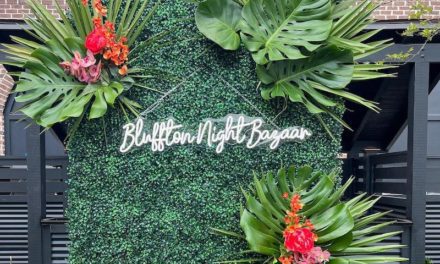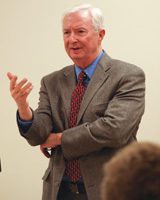Gardens and historic graveyards in the Old Commons neighborhood will be opened to visitors during a walking tour of historic sites scheduled Saturday, May 17, 11 a.m. – 2 p.m. by the neighborhood association.
 The tour will be accompanied by a fish fry sponsored by the Sons of Beaufort Lodge #36 at which neighborhood church gospel choirs and The Foundation, a rhythm and blues band, will perform. Neighborhood storytellers at various sites will round out the activities of the fundraiser which will benefit the restoration of 607 West Street, the lodge building that houses the Sons of Beaufort.
The tour will be accompanied by a fish fry sponsored by the Sons of Beaufort Lodge #36 at which neighborhood church gospel choirs and The Foundation, a rhythm and blues band, will perform. Neighborhood storytellers at various sites will round out the activities of the fundraiser which will benefit the restoration of 607 West Street, the lodge building that houses the Sons of Beaufort.
The tour is the fourth fundraiser held by the neighborhood association and lodge members to match a grant awarded by the South Carolina Department of Archives & History to Historic Beaufort Foundation for restoration of the 120-year-old building. Organizers hope that the success of the walking tour will mean restoration will begin in May.
The Lodge has been used as a meeting hall by black residents from its beginning. Purchased by Lodge #36 in 1937, it was in regular use until demolition of interior alterations started last year. Both Richard Gleaves, the first black SC lieutenant governor, and Robert Smalls, the first black U.S. senator from SC had ties to this building.
Tickets to the tour are $15 each and are available in advance at Lulu Burgess in Old Bay Marketplace on Bay Street or at Singleton’s Barbershop, 815 Charles Street. Tickets will be sold at the Lodge at 607 West Street on the day of the tour. Tickets for the fish fry are $8 for a complete dinner and will be available the day of the tour also at 607 West Street. Parking is available at 607 West Street.
An original oil painting, Common Variety painted and donated by Beaufort artist Rebecca Davenport will be available for purchase with a ticket.
Musical groups include The Foundation and choirs from Wesley United Methodist Church, Second Pilgrim Baptist Church, St. Helena Episcopal Church and Baptist Church of Beaufort. The list of sites follows with historical information provided by Historic Beaufort Foundation.
Tabernacle Baptist Churchyard (c. 1810). This church and its historic churchyard are significant not only for their place in African-American history but for the leadership its parishioners have provided in the community since its breakaway from the Baptist Church of Beaufort during the Civil War. Note the gravestones of Robert Smalls, a former slave who became a Union hero during the Civil War, and his family. Smalls played a leading political role in South Carolina until his death in 1915. Other graves date as early as 1817 when yellow fever killed 1/3 of the town’s population.
The William E. Clark House Garden, 811 North Street (c. 1810). This house, much altered c. 1870 and 1990, is surrounded by a garden cum playground. Planted by an accidental gardener who does not take himself or his garden too seriously, the secret spaces include a happenstance of plants and placement that provide a cool oasis on a busy downtown corner. The gardener’s own artwork provides a folly that reflects the fun he finds in gardening.
The Sam Mulligan House Garden, 813 King Street (c.1880). Built by Sam Mulligan, a freed slave and carpenter, this house has a new and private garden that gives its owner a Zen-like view from many rooms in the house. Its design and low-key plant materials reflect the simplicity of the Orient, as does the granite fountain designed by owner Rebecca Davenport. Japanese pines and Japanese maples lend to the peace of the setting. The “panes” atop the fence mimic the large expanse of window panes across the back of the house. A vegetable garden provides fresh produce on demand.
The Lubkin & Stocks Homes Garden, 808 & 810 King Street, c. 1935 & 1995. As you enter the garden gate, you will see eclectic garden art including a claw foot bathtub now fish pond, and an iron bedstead now herb bed. Staghorn ferns grow on the headboard and larger staghorn ferns are found in the inner courtyard. Notice “Spencer’s Garden” where grandparents and grandson work together. All mosaic art on the steps of the Lubkin House was created by owner Jerry Stocks. As you exit the back gate, notice the exotic ferns and the bottle tree.
“North Street Nostalgia,” 607 West Street grounds. The stories of two little girls who grew up on nearby North Street in the 1930s & 40s are told by the women who lived them, Marianne M. Chenault and Delo Washington. Stop by and hear a tale of a simpler bygone era that is remembered fondly.
Wesley United Methodist Churchyard, 701 West Street, dedicated 1849. Owned and occupied by an active African-American congregation since the Civil War, this frame vernacular church and its historic cemetery have an important history in southern Methodism. It is one of several antebellum white churches that were used as schools for freed slaves during the Civil War. Notable in its cemetery is the grave of the Rev. George Newcomb, a white northern clergyman who lived in Beaufort during the Union Occupation and returned in 1867 to pastor the African-American congregation.
The Greaves-Washington House Garden, 804 West Street, (c. 1887). Home for 25 years to an active professional couple and their children, this house has also been home to a granddaughter of Robert Smalls and her husband, Yaddie Bampfield Simpson and Dr. Charles Simpson, and to long-time Beaufort sheriff George Reed. A pierced brick wall and bright seasonal flowers enhance this large in-town garden.
The Singleton Garden, 1010 West Street. George Singleton grew up in this family home and as a boy was in charge of tending the garden. Today his gardening techniques are akin to those his mother and aunt taught him. When he returned to Beaufort as a retiree, he again began to till the soil of his boyhood, planting collards, tomatoes, onions, beans, strawberries and a variety of hot peppers, all of which he shares with family and friends. If you’re lucky, he’ll invite you back when his crops come in!
“Pazant’s Porch Stories,” 803 Green Street. The Frazier-Pazant family has a long and illustrious Beaufort history. With three historic homes at this corner, the family compound has been home to generations of teachers and musicians. Matriarch Rosalie Pazant, 91, founded the popular Gullah Festival held annually in May and her stories will take you back over 100 years.
Old Commons Lane Gardens & Storytellers. Peek into these surprising sanctuaries on the neighborhood’s only alley. These secret spots are tended by gardeners Anne Roberts, Linda Smith, Mimi Glenn and Amy and Les York. They prove small can be as beautiful and varied as large! Experience Dottie McDaniel’s “sky room,” a parking space converted to a cool outdoor room for conversing with passers-by or reading the morning paper. Visit with Grace White, Beaufort’s first female attorney and keeper of Beaufort’s 20th century history, and hear some tales too confidential to tell.
St. Peter the Apostle Roman Catholic Churchyard, 710 Carteret Street, c. 1846. Michael O’Connor, a devout Irish Catholic, came to Beaufort in 1822 where he operated a hotel on Bay Street. With no Catholic church here, O’Connor arranged to have a priest make regular visits to say Mass at the O’Connor home. Later he and his wife gave the property for this church. O’Connor and his wife, Mary, are buried in the churchyard. Franklin Talbird, who was responsible for much of the masonry work in Beaufort, built the cemetery wall.
Bythewood House Garden, 711 Prince Street, c. 1792. In the first half of the 19th century, this garden was known for its roses. The present gardeners recalled its legacy by planting 200 white ‘iceberg’ roses and a variety of white lily directly descended from those in the Bythewood Garden in the 1860s. In honor of the Marquis de Lafayette’s visit to America in 1825, the Bythewoods redesigned the garden in the French formal style. Three generations of Bythewood women and men gardened here until the Civil War when the family fled in advance of Union troops. Restored in 2004, the garden today, all white, includes gardenias, white crape myrtle, Confederate Jessamine, and the family lilies against the green of boxwoods, palmettos and the red of handmade brick.








